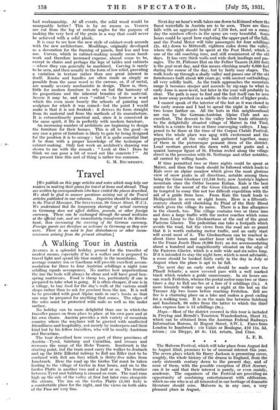The Modern Home
[We shall be pleased to reply to any enquiries arising from the articles we publish on the Modern Home page. Enquiries should be addressed to the Editor, The SPECTATOR, 99 Gamer Street, W.C. 1, with " Modern Home rage" written in the left-hand corner of the envelope.]
Plywood in Furniture—II
THERE is, or there should be, a close relationship between furniture and architecture. The brothers Adams were not content merely to design their houses : they completed their schemes in a way which still delights us by designing the furniture to go in them. It is not, therefore, surprising that modern architecture, which differs so widely from that of preceding periods, has felt the need of a new style of furniture to match its aims.
In spite of all that has been done with metal and glass, one must still feel that, in nine cases out of ten, wood is the perfect material for furniture. It is easily worked and can be cheap or expensive according to our tastes. It is warm to the touch and restful in appearance. Lastly, it possesses an inherent beauty which need only be allowed to display itself to make any additional ornament seem unnecessary— and this applies even to the cheapest, commonest kinds. Whatever hard things may be said of modern furniture, one must allow that it has revealed the beauty of wood to an extent never before attained.
We have seen how multiple and laminated ply place at the disposal of the designer a material which neither warps, expands nor shrinks, which is equally strong in every direction, and which relieves him, therefore, of the necessity for using a frame and panel construction. He is free to revel in all the plain surfaces—and plane surfaces—that he likes. For their embellishment he asks nothing better than to be allowed to use the beauty of the wood itself, unadorned. Not of the actual ply, probably, since the manner in which it is peeled off round and round the trunk tends to produce a somewhat uninteresting grain. He is able to draw upon a wider range of woods, in the form of veneer, than has ever been available before. Birch and bubinga, sycamore and zebrawood, locust and calambour—the forests of the whole earth are being scoured to provide him with timbers of new and beautiful grain. There still seems to cling to the word " veneer " some faint flavour of contempt, as though it were a cheap and meretricious covering used primarily to conceal
bad workmanship. At all events, the solid wood would be unarguably better f This is by no means so. Veneers are cut from the log at certain angles for the purpose of making the very best of the grain in a way that could never be achieved with a solid plank.
It is easy to see how the new style of cabinet-work accords with the new architecture. Mouldings, originally developed as a decoration for the framing of panels, find less and less use. Curves, which in cabinet-making usually mean hand- work and therefore increased expense, almost cease to be, except in chairs and perhaps the legs of tables and cabinets —where they can generally be machined. Carving is rarely to be seen, and then usually in the form of low relief, providing a variation in texture rather than any great interest in itself. Knobs and handles are often made as simply as possible from the same wood as the carcase, or, if of metal, are usually severely mechanistic in design. There is, then, little for modern furniture to rely on but the harmony of its proportions and the inherent beauties of its material. Severe it may be, and even " cubist "—to borrow a word which fits even more loosely the schools of painting and sculpture for which it was coined—but the point I would make is that it is not freakish : it derives its form straight from its material and from the methods of its manufacture. It is extraordinarily practical and, since it is conceived in the same spirit, it fits in perfectly with modern furniture.
An increasing number of architects are beginning to design the furniture for their houses. This is all to the good—in any case a piece of furniture is likely to gain by being designed for the position it is to occupy • but it is quite essential that it be done with a proper knowledge of the technique of cabinet-making. Only last week an architect's drawing was shown to me with the remark : " Look at this ! Does he think we can pour a bit of wood out like concrete ? " At the present time this sort of thing is rather too common.
G. M. HOITMPHREY.











































 Previous page
Previous page